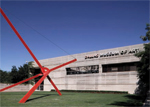
The Art of Collaboration
Dallas museum moves TSA cargo-screening in-house
- By Megan Weadock
- Jul 01, 2010
People who are new to the Dallas-
Fort Worth area may be surprised
to hear about its burgeoning
art scene. It’s true: Dallas is a lot
more cultured than one might expect.
And the Dallas Museum of Art has
been a cornerstone of the city’s rebirth
since it opened in the early 1900s.
Vital to Dallas’ booming Arts District,
the DMA includes more than
23,000 pieces of art from around the
world and hosts countless events each
year. The museum’s monthly Late
Night program alone draws up to
5,000 visitors. And recently, it hosted
nearly 800,000 people in an eight-month
period for its exhibition of
King Tut artifacts. With this kind of
attendance, securing the art -- and the
visitors and staff themselves -- is an
impressive feat.
Lance K. Childers, director of security
at the DMA, said the museum
just took a huge step toward better
safeguarding its art by achieving Transportation
Security Administration air
cargo certification. With this coup, approved
DMA employees will be able to
scan international art shipments themselves
to comply with TSA’s new cargo screening
requirements.
Special Attention
In 2007, TSA mandated that 100 percent
of air cargo transported in passenger
planes must be screened by airlines
as part of the 9/11 Bill. For museums,
meeting the August deadline creates
unprecedented complications.
“Some of those canvases and materials
may be 100 or more years old,”
Childers said. “We’ve got to preserve
it. [Museum employees] package it
in special ways. So we’re apprehensive
[when] it goes to the airport
and they’re going to ship it. I’m sure
they use every precaution they could,
but the art is really special and needs
special attention.”
Often, temporary exhibitions present
even more complicated security
challenges for the museum. The sensitive
nature of the art means much of
it can’t be touched or even exposed to
too much light. In fact, certain paintings
must be covered up for at least 12
hours a day.
But as of April, the DMA is TSA certified
to screen its own international art
shipments. Becoming a certified cargo screening
facility -- a process that took
the DMA about 18 months -- enables
specially trained staff to inspect and
seal each piece of art before it heads to
the airport, which helps ensure that the
cargo isn’t tampered with.
TSA’s Certified Cargo Screening
Program was developed as a solution to
help industries reach the new screening
mandate. TSA says most CCSP shipper
participants have been able to quickly
incorporate physical screening into
their shipping process, at only a small
cost to their operation.
By enabling museums and other facilities
to screen their own packages,
TSA helps ease the burden of its own
employees. Otherwise, it would be a
struggle for U.S. airports to meet the
100-percent cargo-screening requirements
while also ensuring passenger and
staff safety, even when using advanced
screening technology and K-9 teams.
Handle With Care
Brent Mitchell, the DMA’s registrar
for loans and exhibitions, is one of the
museum’s TSA-certified employees. He
said by avoiding any third-party handling
of the museum’s cargo, the art is
better protected. In the meantime, dangers
like improvised explosive devices --
one of the most common threats in air
cargo security -- are avoided.
Mitchell, along with about a dozen
other certified staff members, was required
to undergo a background check
and receive special training. During the
screening process, a staff member inspects
the inside, outside and contents
of each crate in a designated screening
area, which only approved employees
can access. After a crate is inspected, it
is sealed with tamper-evident tape that
features a unique coding system.
“Our main objective is to make sure
when we pack artwork at the museum
that we’re responsible for -- whether it’s
our objects or a lender’s objects -- that
all opening and inspection of the crates
is done by professional art handlers,
such as our staff or contract staff,”
Mitchell said.
Museums that are not certified
cargo-screening facilities must rely on
third-party screeners, such as certified
fine-art shippers or packers. In this case,
Mitchell explained, museum officials
would have to pack each crate on site
and send it with a courier to the third-party
screener, who would then unpack
and inspect it before resealing it and
sending it to the airport. Clearly, this
process would present a much greater
threat to delicate works of art.
Take No Chances
Childers and his team also face special
security and safety challenges within
the permanent exhibition areas. The
main objective is to preserve the art
while still providing a meaningful and
educational opportunity for guests.
In a museum that features priceless
paintings and artifacts, however, guests
themselves can be a liability. Some pieces
of art are fragile enough to be damaged
by people’s breath if they stand
too close, and touching a painting can
cause even greater harm.
Working with the museum’s curators,
Childers determines the security
needs of each piece. By using security
cameras, lasers, motion alarms and
museum attendants -- as well as physical
barriers such as raised platforms
and ropes -- they ensure that the artwork
is as secure as possible from theft
and damage.
Learn more about the Dallas Museum
of Art -- and the Dallas-Fort Worth
metroplex -- at ASIS 2010, which runs
Oct. 12-15 at the Dallas Convention
Center. For more information, visit
http://www.asisonline.org.
About the Author
Megan Weadock is a communications specialist at Monitronics.